|
On October 7, 1805, Lewis and Clark and the
"Corps of Discovery" began their journey
down the Clearwater River and into the volcanics
of the Pacific Northwest. The Corps travelled from the
Clearwater to the Snake and down the
"Great Columbia", finally reaching the
Pacific Ocean on November 15, 1805.
Along the journey they encountered the
lava flows of the Columbia Plateau,
river channels carved by the great "Missoula Floods",
and the awesome beauty of five Cascade Range volcanoes.
|
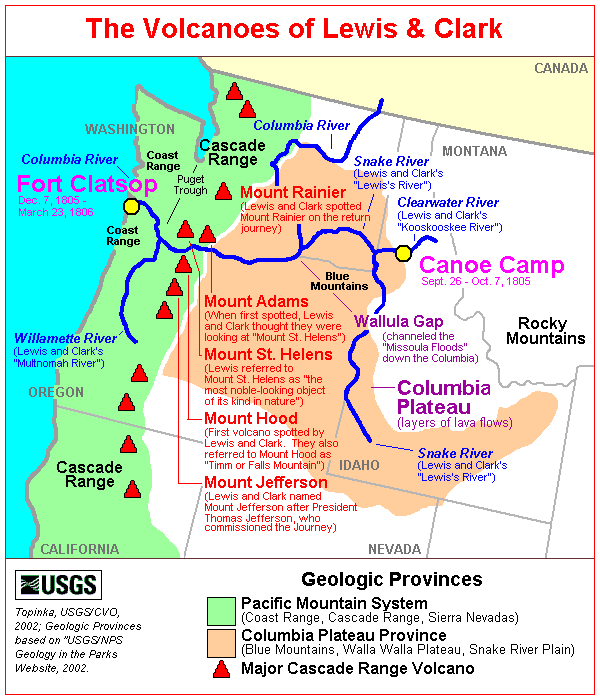
(Click map for brief summary about the area)
-
[
Top of Page]
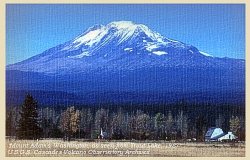
|
Mount Adams, Washington
Mount Adams, at 12,276 feet, is one of the largest volcanoes in the Cascade Range.
Lewis and Clark either mis-identified this peak, or simply called it a "a high
humped Mountain to the East of Mt St. Helians".
[More]
|
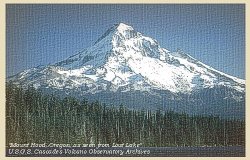
|
Mount Hood, Oregon
Mount Hood, at 11,245 feet high, dominates the Cascade skyline from the Portland metropolitan area to the wheat fields of Eastern Oregon. Mount Hood is the fourth highest peak in the Cascades and the highest in Oregon. The volcano had erupted a few years before the Lewis and Clark journey.
[More]
|
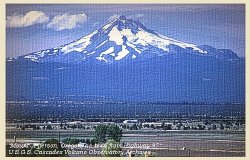
|
Mount Jefferson, Oregon
The 10,495-feet-high Mount Jefferson was named by Lewis and Clark on March 31, 1806.
They named it after the then President Thomas Jefferson, who funded their journey.
[More]
|
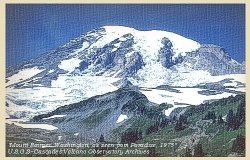
|
Mount Rainier, Washington
Mount Rainier is the highest (14,410 feet) and third-most voluminous volcano in the Cascades. The Mountain is, however, the most dangerous volcano in the range, owing to the large population and to the huge area and volume of ice and snow on its flanks that could theoretically melt to generate debris flows during cataclysmic eruptions.
[More]
|
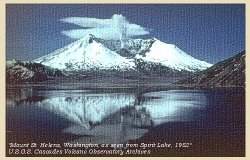
|
Mount St. Helens, Washington
Mount St. Helens was 9,677 feet high before May 18, 1980, when it erupted sending a plume of ash 15 miles high, and destructive mudflows miles downriver. Today the peak is 8,364 feet high, with a north-facing crater and a new lava dome.
Lewis and Clark observed this peak along the journey and comment on the fact you can see Mount St. Helens from the mouth of the Columbia River.
[More]
|
-
[
Top of Page]

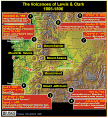
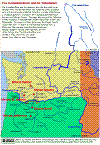
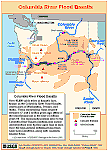
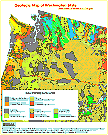
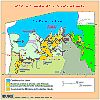
-
Lewis and Clark in the Pacific Northwest
Volcanoes, Lava Flows, Rivers, Canoe Camp, and Fort Clatsop. A map of the volcanic area Lewis and Clark and the "Corps of Discovery" passed on their way to the Pacific.
(Click map to enlarge)
-
Lewis and Clark Volcano Sitings
Marked locations where Lewis and Clark sited the "Volcanoes of Lewis and Clark". Mount Rainier, Mount St. Helens, and Mount Adams are in Washington State. Mount Hood and Mount Jefferson are in Oregon. Lewis and Clark named Mount Jefferson.
(Click map to enlarge).
-
The Columbia River and its Tributaries
The Columbia River and its tributaries form the
dominant water system in the Pacific Northwest. The
mainstem of the Columbia rises in Columbia Lake in
British Columbia, Canada. After flowing a circuitous
path for 1,270 miles, the Columbia joins the Pacific
Ocean near Astoria, Oregon. The major tributaries of
the Columbia are the Kootenai, Flathead/Pend
Oreille/Clark's Fork, Snake, and Willamette. The
largest of these, the Snake, travels 1,038 miles from
its source in Yellowstone National Park in Wyoming.
The massive Columbia River basin was formed 12,000 to
19,000 years ago near the end of the last Ice Age.
The Columbia river was
named in 1792, by American Captain Robert Gray, after
his ship "Columbia".
(Click map to enlarge).
-
Columbia River Flood Basalts
The Columbia River passes through lava flow upon lava flow.
During late Miocene and early Pliocene times
(between 17 and 6 million years ago),
one of the largest basaltic lava floods ever to
appear on the earths surface engulfed about
63,000 square miles of the Pacific Northwest.
Over a period of perhaps 10 to 15 million
years lava flow after lava flow poured out,
eventually accumulating to a thickness of
more than 6,000 feet.
Over 300 high-volume individual lava
flows have been identified, along with
countless smaller flows.
Numerous linear
vents, some over 90 miles long, show
where lava erupted near the eastern edge of
the Columbia River Basalts. Older vents
were probably buried by younger flows.
As the molten rock came to
the surface, the earths crust gradually
sank into the space left by the rising lava. The
subsidence of the crust produced a large,
slightly depressed lava plain now known as the
Columbia Basin (Plateau). The ancient
Columbia River was forced into its present course by
the northwesterly advancing lava.
(Click map to enlarge).
-
Geologic Map of Washington State
With Select Stratigraphic Units.
(Click map to enlarge).
-
The Cordilleran Ice Sheet and the Missoula Floods
With the beginning of the Pleistocene
time, about one million years ago, cooling
temperatures provided conditions favorable
for the creation of great sheets of moving ice.
Thus began the Ice Age.
At the end of the last Ice Age, a finger
of the Cordilleran ice sheet crept southward into the
Idaho panhandle, forming a large ice dam
that blocked the mouth of the Clark Fork River,
creating a massive lake 2,000 feet deep
and containing more than 500 cubic miles of water.
Glacial Lake Missoula stretched eastward
for some 200 miles and contained more water
than Lake Erie and Lake Ontario combined.
When the highest of these ice dams failed, lake
water burst through, shooting out at a rate
10 times the combined flow of all
the rivers of the world.
This towering mass of water and ice
literally shook the ground as it thundered toward the
Pacific Ocean, stripping away hundreds
of feet of soil and cutting deep canyons -- "coulees"
-- into the underlying bedrock. With
flood speeds approaching 65 miles per hour,
the lake would have drained in as little as 48 hours.
Over time the Cordilleran ice sheet
continued moving south and blocked the Clark Fork
River again and again, recreating Glacial
Lake Missoula. Over approximately 2,500 years,
the lake, ice dam and flooding sequence
was repeated dozens of times, leaving a lasting
mark on the landscape.
(Click map to enlarge).
-- Excerpts from:
U.S. Army Corps of Engineers Website, 2002,
USGS/NPS Geology in the Parks Website, 2002,
U.S. National Park Service, Lake Roosevelt National Recreation Area Website, 2002,
U.S. National Park Service, Ice Age Floods Website, 2002,
U.S. National Park Service, National Natural Landmarks Program Website,
2002,
and
U.S. Forest Service, Columbia Gorge National Scenic Area Website, 2002
|
-
[
Top of Page]
|
Lewis and Clark and the "Corps of Discovery"
|
|
"take notice of the country you pass through, it's general face, soil, river, mountains, it's productions animal, vegetable, & mineral so far as they may be new to us & also be useful; the latitudes of places ...; the names, numbers, & dwellings of the inhabitants, and such particularities as you can learn of them."
-- President Thomas Jefferson - April 30, 1793
|
In 1803,
President Thomas Jefferson commissioned Meriwether Lewis, who along with his friend William Clark, lead an expedition on an epic journey to explore the headwaters of the Missouri River and find an overland route to the Pacific Ocean by way of the Columbia River. The "Corps of Discovery" departed Camp DuBois near Wood River, Illinois, on May 14, 1804, and proceeded up the Missouri River using a keelboat and two "pirogues". After several councils with the Indian Tribes on the lower Missouri River, and the unfortunate death of Sergeant Floyd near present Sioux City, Iowa, the party reached the Knife River Indian Villages, near present Washburn, North Dakota. There they built Fort Mandan and spent a productive winter gathering information about the Indian Tribes and the lands to the west. They also recruited as interpreters, the Frenchman Toussaint Charbonneau and his Shoshoni wife, Sacagawea. In the spring of 1805, the permanent party continued up the Missouri River in the pirogues and dugout canoes. After an arduous portage around the Great Falls of the Missouri, they reached the headwaters of that great river. Now on foot, the party encountered a band of Shoshoni Indians, coincidentally led by Sacagawea's brother Cameahwait. The Shoshoni assisted the expedition by providing horses and a guide to cross the rugged Bitteroot Mountains. After a difficult crossing on what is now known as the Lolo Trail, the party met the friendly Nez Perce Indians. They left their horses with the Indians and once again made canoes.
Navigating down the Clearwater, Snake, and Columbia Rivers, the Corps of Discovery reached the Pacific Ocean in November 1805. The party built Fort Clatsop on the south side of the Columbia River near present Astoria, Oregon, where they spent a cold, rainy winter. In the spring and summer of 1806, the expedition made their way back
across the mountains, explored several major rivers in present day Montana, and made their way back down the Missouri River to St. Louis, arriving on September 23, 1806. The Lewis and Clark National Historic Trail is approximately 3,700 miles long, begins near Wood River, Illinois, and passes through portions of Missouri, Kansas, Iowa, Nebraska, South Dakota, North Dakota, Montana, Idaho, Oregon, and Washington.
-- U.S. National Park Service, 2002,
Fort Clatsop National Memorial Website, and
Lewis & Clark National Historic Trail Website
|
-
[
Top of Page]
|
About the Reference Materials
|
Main Text Excerpts from:
History of The Expedition Under the
Command of Captain's Lewis and Clark,
to the Sources of the Missouri, thence Across
the Rocky Mountains, and down the
River Columbia to the Pacific Ocean,
Performed during the years 1805-5-6,
By order of
the Government of the United States.
Prepared for the Press by Paul Allen, Esquire., Vol. II. Published by
Bradford and Inskeep, Philadephia,
and Abm. H. Inskeep, New York. J. Maxwell, Printer., 1814.
("Biddle/Allen Publication")
Online at: Library of Congress/American Memories Website,
2002; Collection from:
The First American West: The Ohio River Valley 1750-1820,
Special Collections Research Center, University of Chicago Library, and
The Filson Historical Society.
About the Biddle/Allen publication:
Captain Lewis was supposed to have edited the journals for publication,
but he met with an untimely death, probably by murder, while
traveling through Tennessee in 1809. The task then fell to Clark,
who asked the Philadelphia lawyer Nicholas Biddle, to complete the job.
Biddle agreed, but soon passed the work on to Paul Allen, a
Philadelphia journalist. The journals were finally edited and made ready for
publication in 1812, but were not published until February 20, 1814.
Originally, an edition of 2,000 was to be printed, but when missing
copies were tallied and defective copies weeded out, only 1,417 remained.
These sold at six dollars a copy. The Biddle-Allen revision of
the Lewis and Clark journals left intact the raw quality of diaries
written in the wilderness, retaining their sense of danger and high
adventure.
-- Excerpt from:
Treasures of the University of Delaware Library
Additional Quotations and Journey Logs from:
The Journals of the Lewis & Clark Expedition,
Gary E. Moulton, Editor,
University of Nebraska Press, Lincoln and London,
volumes 5, 6,7, 9, 10, and 11
About the Moulton publications:
Dr. Gary Moulton at the University of Nebraska has compiled the
first complete set of journals relating to the Lewis & Clark Expedition. The result of this project
(beginning in 19__) is a 13-volume set (as of November, 2002) that includes Clark's maps, the
Journals of Meriwether Lewis, William Clark, Patrick Gass, Joseph Whitehouse, John Ordway, and
Charles Floyd. This set of books are the most accurate copies of the actual journals. Previous
versions of the Journals have actually been condensed collections and interpretations of the known
journal documents.
-- Information courtesy: The Lewis & Clark Expedition Website, 2002
A History of Lewis and Clark Journals:
- Patrick Gass Journal:
Seargeant Patrick Gass's (1771-1870)
journal first published in 1807,
appeared seven years before the official
Lewis and Clark narrative. Gass
was promoted to sergeant at the death
of Charles Floyd, the only man to die on
the expedition.
In 1812, two engravings were added by
Matthew Carey of Philadelphia to the
1812 publication of the journal of
Sergeant Patrick Gass, the
first eyewitness accounts of the
expedition to be made public. The
pictures were said to depict actual
incidents in the Lewis and Clark journey.
-- Information courtesy: U.S. Library of Congress Website, 2002
- Biddle/Allen:
The official publication of the journals of Lewis and Clark did
not appear until 1814,
nearly eight years after the return of
Lewis and Clark.
Lewis, who was given the responsibility of
preparing the journals for publication, died prematurely in
1809.
Clark asked Jefferson to edit the
journals, but Jefferson demurred --
he had retired and was devoting his
time to Monticello and the University of Virginia.
Clark felt diffident
about his own skills and so sought a
professional for the work.
Nicholas Biddle assumed the
task of editing the journals, but before completing the task
turned the effort over to Paul Allen.
The long awaited work,
often referred to as the Biddle-Allen edition, was finally
published in 1814 when 1,417 copies of the two-volume
work were made available for purchase.
The journals appeared in London in the
same year as a one-volume work with a map. They were
published again in England in 1815 and 1817 as
three-volume sets. Dutch translations of the journals
appeared in three volumes in 1816, 1817, and 1818. An
edition of the journals also was
published in Dublin in 1817 in
two volumes. All of these early publications of the journals
were condensed narratives of the actual journal entries,
derived from the editing of Biddle and Allen.
-- Information from:
Lewis & Clark College Website, 2002, and
Stephen E. Ambrose, IN: Bernard DeVoto, (ed.),
1953, The Journals of Lewis and Clark: New York,
Mariner Books Houghton Mifflin Company, 504p.,
reprinted in 1997
- Harper Family Library:
No known editions of the journals appeared again until 1842 when a
smaller format edition was published as a part of the Harper Family Library.
This edition was reprinted seventeen times through the 1860's, not
inconsequentially coinciding with the settlement of the territory that the
Corps of Discovery explored.
-- Information courtesy:
Lewis & Clark College Website, 2002
- Elliott Coues:
In 1893 Elliott Coues re-edited the journals.
The Coues version was published by Francis
Harper in four volumes limited
to 1,000 sets, 200 of which were
issued in a large paper format.
-- Information courtesy:
Lewis & Clark College Website, 2002
- Reuben Gold Thwaites:
Coinciding
with the Centennial observation of the Expeditionis 1904, all the known
journals were printed in their entirety for the first time.
This edition, edited
by Reuben Gold Thwaites, came out in an eight-volume trade edition and in
two limited edition sets. The limited edition sets were
printed in runs of 200
and 50 with the latter printed on Japanese hand-made rice paper and with
hand-tinted color plates by Karl Bodmer. The Thwaites edition stood as the
most complete compilation of the journals for eight decades until Gary
Moulton began editing the journals in the late 1970s.
-- Information courtesy:
Lewis & Clark College Website, 2002
- Bernard DeVoto:
It was not until 1953, a century and a half
after they were writtten, that the journals became available to a large
public. That year, Houghton Mifflin Company brought out Bernard DeVoto's
one-volume condensation of the journals. Since then it has been
continuously in print, and read by hundreds of thousands. The success is
well earned. It is a superb work.
-- Excerpt from:
Stephen E. Ambrose, IN: Bernard DeVoto, (ed.),
1953, The Journals of Lewis and Clark: New York,
Mariner Books Houghton Mifflin Company, 504p.,
reprinted in 1997
- Dr. Gary Moulton:
Dr. Gary Moulton at the University of Nebraska has compiled the
first complete set of journals relating to the Lewis &
Clark Expedition. The result of this project
(beginning in 1983) is a 13-volume set (as of November, 2002)
that includes Clark's maps, the
Journals of Meriwether Lewis, William Clark, Patrick Gass,
Joseph Whitehouse, John Ordway, and
Charles Floyd. This set of books are the most accurate
copies of the actual journals. Previous
versions of the Journals have actually been condensed
collections and interpretations of the known
journal documents.
-- Information courtesy:
Lewis & Clark College Website, 2002, and
The Lewis & Clark Expedition Website, 2002
About the early 1:125,000 Topographic Maps:
Washington 1:125,000 topographic quadrangles --
This set of maps represents some of the earliest attempts to map
Washington by the United States Geological Survey. Created by an act of
Congress in 1879, the USGS set out to create a set of
topographic maps of the entire United States beginning in 1882. One sheet of this set,
is referred to as a quadrangle. The standard quadrangle
consists of 30' of latitude and 30' of longitude at a scale of 1:125,000. Many people
are familiar with modern USGS topographic maps that
cover 7 ?' x 7 ?'. These modern maps are four times more detailed than the maps
featured on this site.
While the USGS created most of these maps
in the late 19th and early 20th century, they continued to reprint the sheets into the 1960s. When
a sheet was reprinted, it remained largely unchanged.
The USGS prioritized which areas of the United States should be mapped.
The result is that many areas in Washington with little population
density or natural resources were not mapped for 60 or 70 years.
That is why there are no sheets for much of the Olympic Peninsula and parts
of central Washington. Maps were simply never produced for many
of these areas until the 1960s or later.
-- Information courtesy: University of Washington Library Collections Website, 2002
|
-
[
Top of Page]
|
USGS Lewis and Clark Links
|
-
The Lewis and Clark Expedition and the USGS
The Lewis and Clark Expedition was the first of many government surveys of natural resources in the American West. The U.S. Geological Survey (USGS) was established on March 3, 1879 in response to a report from the National Academy of Sciences, which had been asked by the Congress in 1878 to provide a plan for surveying and mapping the Territories of the United States that would secure the best possible results at the least possible cost. The USGS continues to serve the nation as an independent fact-finding agency that provides scientific understanding about natural-resource conditions, issues, and problems. Because of its origin in natural resource surveys and the similarity of the USGS mission to Thomas Jefferson's charge to Meriwether Lewis, the USGS can be seen as the organizational successor to Lewis and Clark
-
USGS Resources for Teaching About Lewis and Clark
The USGS publishes nearly 100,000 different maps, aerial photographs, books, booklets, posters, CDs, digital data, and satellite imagery, many of which are useful for teaching about Lewis and Clark, Native Americans, and the cultural and physical geography of the United States, past and present. These resources can be used in an inquiry-based setting in a variety of courses and projects at the elementary, secondary, and university levels. In addition, the USGS hosts Internet-based resources that can be used for teaching about Lewis and Clark.
- USGS Kentucky District Lewis and Clark Bicentennial Celebration ... (offline, 2010)
In the fall of 1803, Thomas Jefferson commissioned the Corps of Discovery under the
command of Meriwether Lewis. Besides seeking the Northwest Passage, Lewis was to map
the new territory, assess its natural resources, and if possible, make contact with its
inhabitants. Both Louisville and Clarksville were significant towns in the early stages of the
Lewis and Clark Expedition, as this is where the infamous "Corps of Discovery" unit was
formed and much of the journey planning was done. The nucleus of the Corps of Discovery -
recruited by William Clark in Louisville and Clarksville - became known as the "Nine Young
Men from Kentucky," even though not all of them were from Kentucky. The initial planning of
the expedition began on October 14, 1803, with the arrival of William Clark at the Falls of
the Ohio. Lewis and Clark met at the Falls to recruit the men and plan the journey route
West. The planning and recruiting spanned the next 12 days, with Lewis, Clark, and the
Corps of Discovery departing from Clarksville down the Ohio River on October 26, 1803.
-
Lewis and Clark and the U.S. Geological Survey in North Dakota
In North Dakota, the U.S. Geological Survey continues many of the scientific
investigations begun by Lewis and Clark and the Corps of Discovery. This web
site gives a picture of the Missouri River and its tributaries during the early
1800's, via excerpts from the journals of Lewis and Clark, and a picture of the
present-day river system, via aerial photographs, U.S. Geological Survey data,
and U.S. Geological Survey publications. Because the production of maps
was another endeavor common to the Corps of Discovery and the U.S.
Geological Survey, the web site also provides a historical view of Missouri River
and North Dakota maps from 1798 to the present.
-
[
Top of Page]
|












